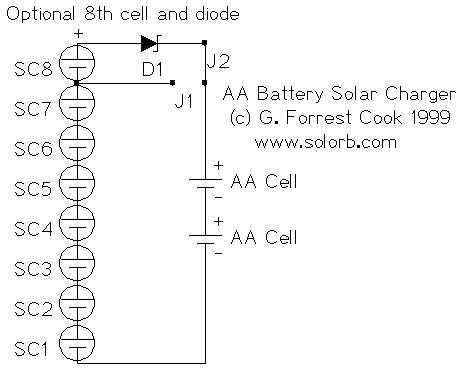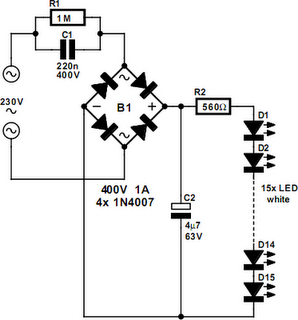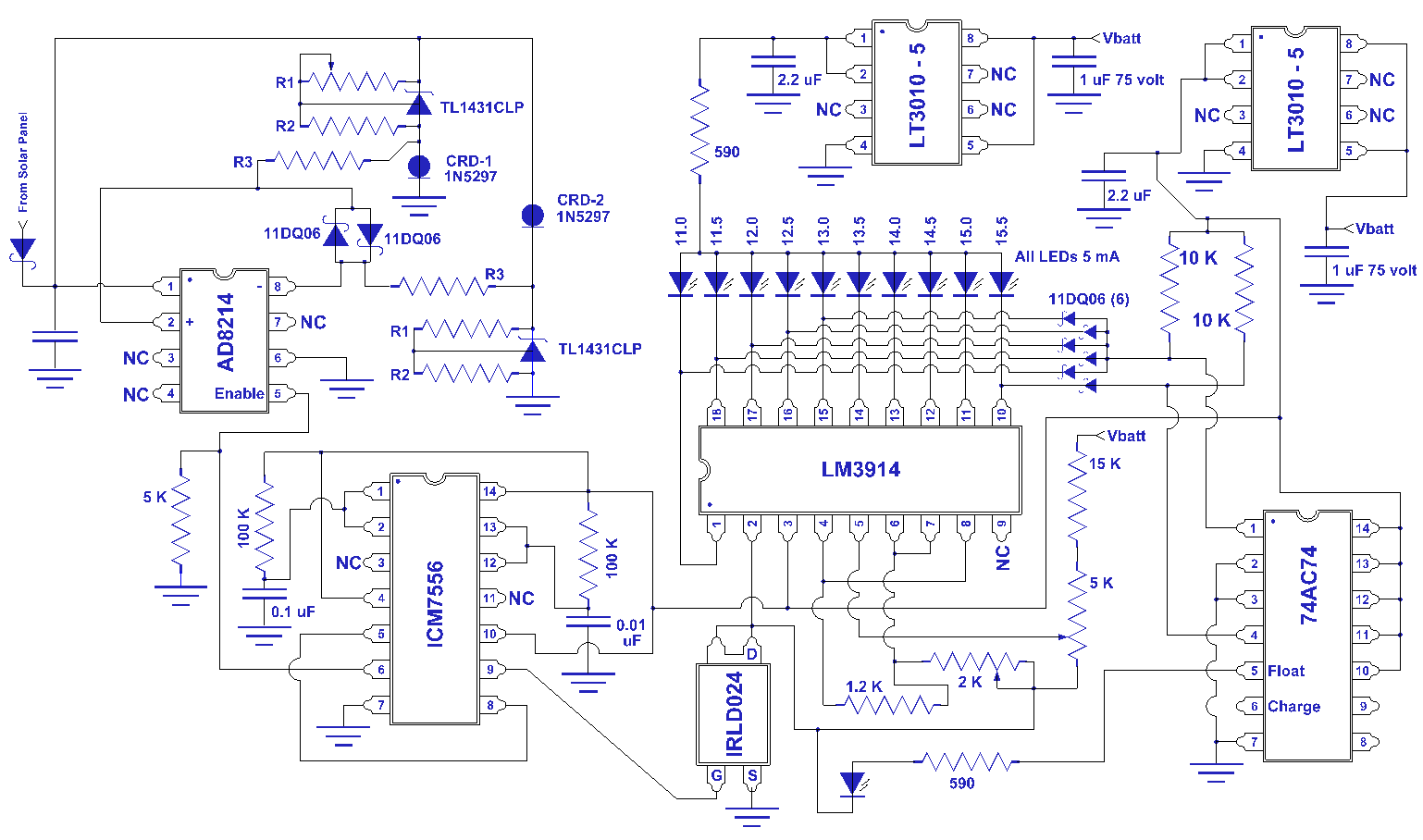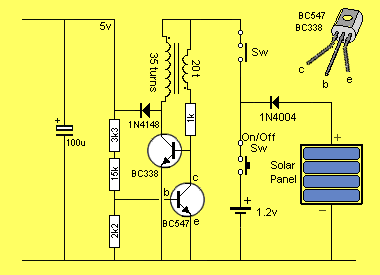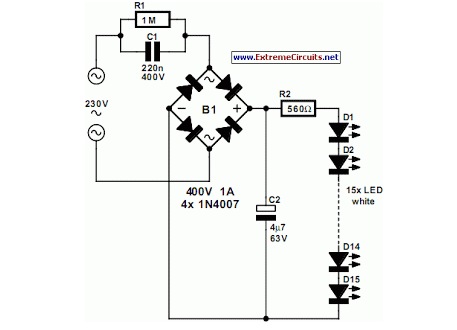
solar powered animal scarer
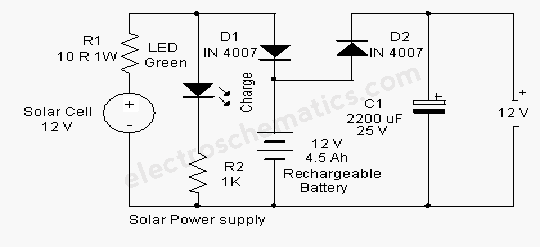
A solar-powered flasher designed to deter nocturnal animals such as bats and cats from agricultural areas or residential premises. The device emits brilliant multicolored flashes that confuse these animals, encouraging them to avoid the area. It operates automatically, activating in the evening and deactivating in the morning. The circuit utilizes a Light Dependent Resistor (LDR) controlled oscillator.
The system is built around the binary counter integrated circuit (IC) CD4060. The operation of the IC is managed through its reset pin (pin 12). During daylight hours, the LDR conducts electricity, maintaining a high signal on the reset pin, which keeps the IC inactive. At night, the LDR stops conducting, allowing the reset pin to be grounded through variable resistor (VR1). This action triggers the IC to begin oscillating, with the timing determined by capacitor (C1) and variable resistor (VR2). Output pins 7, 5, and 4 are employed to power strings of LEDs. VR1 adjusts the sensitivity of the LDR, while VR2 controls the flashing rate of the LEDs. High-brightness red, blue, and white LEDs are utilized to create vivid flashes. The red LEDs flash rapidly, followed by the blue, and then the white LEDs, which remain illuminated for several seconds to provide localized lighting. Additional LEDs can be incorporated into the strings if desired. The circuit is also capable of functioning with a 12-volt DC power supply.
The solar-powered flasher circuit incorporates several critical components to ensure effective operation. The solar panel charges a battery during the day, providing the necessary energy for the circuit to function at night. The LDR serves as a light sensor, detecting ambient light levels and determining when to activate the flasher. The CD4060 IC, known for its versatility in generating oscillations, is configured to produce a range of flashing patterns through the selected capacitive and resistive components.
The choice of LEDs is significant for both visibility and energy efficiency. High-brightness LEDs are selected to ensure that the flashes are noticeable from a distance, effectively scaring away unwanted animals. The use of different colors not only enhances the visual effect but also adds an element of unpredictability, which is crucial for deterring animals that may become accustomed to a single light pattern.
Overall, this solar-powered flasher circuit is an effective solution for protecting agricultural areas and homes from nocturnal animal disturbances, leveraging simple electronic components to create a reliable and automated deterrent system.A solar powered Flasher to scare away the nocturnal animals like bats and cats from the farm yard or premises of the house. The brilliant multicolored flashes confuse these animals and they avoid the hostile situation. It is fully automatic, turns on in the evening and turns off in the morning. The circuit has an LDR controlled oscillator built around the Binary counter IC CD 4060. The functioning of the IC is controlled through its reset pin 12. During day time, LDR conducts and keeps the reset pin of IC high so that it remains dormant. During night, LDR cease to conduct and the reset pin will be grounded through VR1. This triggers the IC and it stats oscillating using the components C1 and VR2. Output pins 7, 5 and 4 are used to power the LEDs strings. VR1 adjusts the sensitivity of LDR and VR2, the flashing rate of LEDs. High bright Red, Blue and White LEDs are used in the circuit to give brilliant flashes. Red LEDs flash very fast, followed by blue and then White. White LEDs remains on for few seconds and provide light to a confined area. More LEDs can be added in the strings if desired. The circuit can also function with 12 volt DC. 🔗 External reference
The system is built around the binary counter integrated circuit (IC) CD4060. The operation of the IC is managed through its reset pin (pin 12). During daylight hours, the LDR conducts electricity, maintaining a high signal on the reset pin, which keeps the IC inactive. At night, the LDR stops conducting, allowing the reset pin to be grounded through variable resistor (VR1). This action triggers the IC to begin oscillating, with the timing determined by capacitor (C1) and variable resistor (VR2). Output pins 7, 5, and 4 are employed to power strings of LEDs. VR1 adjusts the sensitivity of the LDR, while VR2 controls the flashing rate of the LEDs. High-brightness red, blue, and white LEDs are utilized to create vivid flashes. The red LEDs flash rapidly, followed by the blue, and then the white LEDs, which remain illuminated for several seconds to provide localized lighting. Additional LEDs can be incorporated into the strings if desired. The circuit is also capable of functioning with a 12-volt DC power supply.
The solar-powered flasher circuit incorporates several critical components to ensure effective operation. The solar panel charges a battery during the day, providing the necessary energy for the circuit to function at night. The LDR serves as a light sensor, detecting ambient light levels and determining when to activate the flasher. The CD4060 IC, known for its versatility in generating oscillations, is configured to produce a range of flashing patterns through the selected capacitive and resistive components.
The choice of LEDs is significant for both visibility and energy efficiency. High-brightness LEDs are selected to ensure that the flashes are noticeable from a distance, effectively scaring away unwanted animals. The use of different colors not only enhances the visual effect but also adds an element of unpredictability, which is crucial for deterring animals that may become accustomed to a single light pattern.
Overall, this solar-powered flasher circuit is an effective solution for protecting agricultural areas and homes from nocturnal animal disturbances, leveraging simple electronic components to create a reliable and automated deterrent system.A solar powered Flasher to scare away the nocturnal animals like bats and cats from the farm yard or premises of the house. The brilliant multicolored flashes confuse these animals and they avoid the hostile situation. It is fully automatic, turns on in the evening and turns off in the morning. The circuit has an LDR controlled oscillator built around the Binary counter IC CD 4060. The functioning of the IC is controlled through its reset pin 12. During day time, LDR conducts and keeps the reset pin of IC high so that it remains dormant. During night, LDR cease to conduct and the reset pin will be grounded through VR1. This triggers the IC and it stats oscillating using the components C1 and VR2. Output pins 7, 5 and 4 are used to power the LEDs strings. VR1 adjusts the sensitivity of LDR and VR2, the flashing rate of LEDs. High bright Red, Blue and White LEDs are used in the circuit to give brilliant flashes. Red LEDs flash very fast, followed by blue and then White. White LEDs remains on for few seconds and provide light to a confined area. More LEDs can be added in the strings if desired. The circuit can also function with 12 volt DC. 🔗 External reference

